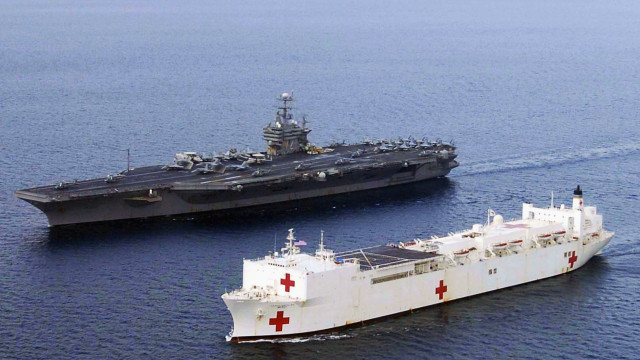




























See Also
See Again
©
0 / 29 Fotos
Astronauts on a mission
- On June 5, 2024, astronauts Sunita Williams and Butch Wilmore set off into space on an eight-day mission.
© Getty Images
1 / 29 Fotos
Issues onboard
- They were traveling on the Boeing Starliner when the spacecraft experienced problems on its way to the International Space Station (ISS), including leaks of helium, which pushes fuel into the propulsion system. Several thrusters also failed to work correctly.
© Getty Images
2 / 29 Fotos
Stuck in space
- These circumstances have left the two astronauts stuck on the ISS for over nine months. But what are some potential risks to their bodies, orbiting around Earth that long?
© Reuters
3 / 29 Fotos
Muscles
- Without the constant tug of gravity on our limbs, muscle and bone mass quickly begin to diminish in space. The most affected areas are the muscles that help to maintain our posture in our back, neck, calves, and quadriceps. This is because in microgravity they no longer have to work nearly as hard.
© Getty Images
4 / 29 Fotos
Muscles
- After two weeks muscle mass can fall by 20%, and on longer missions of three-to-six months, it can fall by 30%.
© Getty Images
5 / 29 Fotos
Bones
- For similar reasons, the bones of astronauts also start to lose strength. In fact, astronauts can lose 1-2% of their bone mass every month they spend in space, and up to 10% over a six-month period. As a comparison, on Earth, older men and women lose bone mass at a rate of 0.5%-1% every year.
© Getty Images
6 / 29 Fotos
Bones
- This can increase their risk of suffering fractures and increased healing time. It can take up to four years for bone mass to return to normal after returning to Earth
© Getty Images
7 / 29 Fotos
Workout in space
- To combat this, astronauts undertake 2.5 hours a day of exercise and intense training while in orbit on the ISS. This includes a series of squats, deadlifts, rows, and bench presses. They also take diet supplements to help keep their bones as healthy as possible.
© Getty Images
8 / 29 Fotos
Not enough
- However, a recent study showed that even this exercise regime wasn't enough to prevent losses in muscle function and size. Higher loads in resistance exercises and high-intensity interval training were recommended after testing.
© Getty Images
9 / 29 Fotos
Weight loss
- Although weight means very little while in orbit, maintaining a healthy weight is a challenge while in space.
© Getty Images
10 / 29 Fotos
Astronaut diet
- Astronauts are provided with a diverse range of nutritious foods, including most recently a few salad leaves grown on board the space station. However, it can still affect an astronaut's body.
© Getty Images
11 / 29 Fotos
Scott Kelly
- NASA astronaut Scott Kelly (pictured) took part in the most extensive study of the effects of long-term spaceflight after staying onboard the ISS for 340 days. Compared to his twin brother who stayed back on Earth, Kelly lost 7% of his body mass while in orbit.
© Getty Images
12 / 29 Fotos
Eyesight
- On Earth, gravity forces the blood in our bodies downward while the heart pumps it up again. Although the body does adapt somewhat in space, this process is disrupted and blood can accumulate in the head more than normal.
© Getty Images
13 / 29 Fotos
Eyesight
- Some of the blood can end up at the back of the eye and around the optic nerve, leading to edema. This can lead to vision changes, such as decreased sharpness and structural changes in the eye itself.
© Getty Images
14 / 29 Fotos
Eyesight
- These changes can start to occur after just two weeks in space. However, the risk increases as time goes on.
© Getty Images
15 / 29 Fotos
Eyesight
- Some of the vision changes reverse within about a year of astronauts returning to Earth, but others can be permanent.
© Getty Images
16 / 29 Fotos
Neural shuffling
- After his time on the ISS, Kelly's cognitive performance was found to have remained relatively similar to his brother's on the ground.
© Getty Images
17 / 29 Fotos
Neural shuffling
- However, researchers noticed that the speed and accuracy of Kelly's cognitive performance decreased for around six months after he landed, possibly as his brain readjusted to the Earth's gravity and his lifestyle back home.
© Getty Images
18 / 29 Fotos
Neural shuffling
- A study on a Russian cosmonaut, who spent 169 days on the ISS in 2014, also found some changes to the brain. It found there were changes in the levels of neural connectivity in parts of the brain relating to motor function, and also in the vestibular cortex.
© Getty Images
19 / 29 Fotos
Friendly bacteria
- One of the keys to good health is the diversity of microorganisms living in and on our bodies. The gut microbiome can influence how we digest food, affect the levels of inflammation in our bodies, and alter the way our brains work.
© Getty Images
20 / 29 Fotos
Friendly bacteria
- Researchers examining Kelly after his trip found that his gut microbiome had changed profoundly. Exposure to radiation, the use of recycled water, and changes to his physical activity could all have played a role.
© Getty Images
21 / 29 Fotos
Skin
- Kelly's skin was found to have heightened sensitivity and he suffered a rash for around six days after he returned from the ISS.
© Getty Images
22 / 29 Fotos
Skin
- Researchers speculated that a lack of skin stimulation during the mission may have contributed to his skin issues.
© Getty Images
23 / 29 Fotos
Genes
- The ends of each DNA strand are called telomeres. They help to protect our genes from damage. As we age, they get shorter, but research on Kelly and other astronauts revealed that space travel seems to alter the length of these telomeres.
© Getty Images
24 / 29 Fotos
Genes
- One possible cause of the change in these telomeres could be exposure to the complex mix of radiation in space.
© Getty Images
25 / 29 Fotos
Genes
- There were also some changes in gene expression, the mechanism that reads the DNA to produce proteins in cells. Some of these are related to the body's response to DNA damage, bone formation, and the immune system's response to stress. However, most of these changes had returned to normal within six months of Kelly's return to Earth
© Getty Images
26 / 29 Fotos
Immune system
- Kelly received a number of vaccines before, during, and after his trip into space and his immune system reacted normally.
© Getty Images
27 / 29 Fotos
Immune system
- However, research has found that astronauts do suffer some decreases in white blood cell counts. This is largely due to the doses of radiation they receive while in orbit. Sources: (BBC) (NASA) (Washington Post) See also: The worst disasters to occur in space
© Getty Images
28 / 29 Fotos
©
0 / 29 Fotos
Astronauts on a mission
- On June 5, 2024, astronauts Sunita Williams and Butch Wilmore set off into space on an eight-day mission.
© Getty Images
1 / 29 Fotos
Issues onboard
- They were traveling on the Boeing Starliner when the spacecraft experienced problems on its way to the International Space Station (ISS), including leaks of helium, which pushes fuel into the propulsion system. Several thrusters also failed to work correctly.
© Getty Images
2 / 29 Fotos
Stuck in space
- These circumstances have left the two astronauts stuck on the ISS for over nine months. But what are some potential risks to their bodies, orbiting around Earth that long?
© Reuters
3 / 29 Fotos
Muscles
- Without the constant tug of gravity on our limbs, muscle and bone mass quickly begin to diminish in space. The most affected areas are the muscles that help to maintain our posture in our back, neck, calves, and quadriceps. This is because in microgravity they no longer have to work nearly as hard.
© Getty Images
4 / 29 Fotos
Muscles
- After two weeks muscle mass can fall by 20%, and on longer missions of three-to-six months, it can fall by 30%.
© Getty Images
5 / 29 Fotos
Bones
- For similar reasons, the bones of astronauts also start to lose strength. In fact, astronauts can lose 1-2% of their bone mass every month they spend in space, and up to 10% over a six-month period. As a comparison, on Earth, older men and women lose bone mass at a rate of 0.5%-1% every year.
© Getty Images
6 / 29 Fotos
Bones
- This can increase their risk of suffering fractures and increased healing time. It can take up to four years for bone mass to return to normal after returning to Earth
© Getty Images
7 / 29 Fotos
Workout in space
- To combat this, astronauts undertake 2.5 hours a day of exercise and intense training while in orbit on the ISS. This includes a series of squats, deadlifts, rows, and bench presses. They also take diet supplements to help keep their bones as healthy as possible.
© Getty Images
8 / 29 Fotos
Not enough
- However, a recent study showed that even this exercise regime wasn't enough to prevent losses in muscle function and size. Higher loads in resistance exercises and high-intensity interval training were recommended after testing.
© Getty Images
9 / 29 Fotos
Weight loss
- Although weight means very little while in orbit, maintaining a healthy weight is a challenge while in space.
© Getty Images
10 / 29 Fotos
Astronaut diet
- Astronauts are provided with a diverse range of nutritious foods, including most recently a few salad leaves grown on board the space station. However, it can still affect an astronaut's body.
© Getty Images
11 / 29 Fotos
Scott Kelly
- NASA astronaut Scott Kelly (pictured) took part in the most extensive study of the effects of long-term spaceflight after staying onboard the ISS for 340 days. Compared to his twin brother who stayed back on Earth, Kelly lost 7% of his body mass while in orbit.
© Getty Images
12 / 29 Fotos
Eyesight
- On Earth, gravity forces the blood in our bodies downward while the heart pumps it up again. Although the body does adapt somewhat in space, this process is disrupted and blood can accumulate in the head more than normal.
© Getty Images
13 / 29 Fotos
Eyesight
- Some of the blood can end up at the back of the eye and around the optic nerve, leading to edema. This can lead to vision changes, such as decreased sharpness and structural changes in the eye itself.
© Getty Images
14 / 29 Fotos
Eyesight
- These changes can start to occur after just two weeks in space. However, the risk increases as time goes on.
© Getty Images
15 / 29 Fotos
Eyesight
- Some of the vision changes reverse within about a year of astronauts returning to Earth, but others can be permanent.
© Getty Images
16 / 29 Fotos
Neural shuffling
- After his time on the ISS, Kelly's cognitive performance was found to have remained relatively similar to his brother's on the ground.
© Getty Images
17 / 29 Fotos
Neural shuffling
- However, researchers noticed that the speed and accuracy of Kelly's cognitive performance decreased for around six months after he landed, possibly as his brain readjusted to the Earth's gravity and his lifestyle back home.
© Getty Images
18 / 29 Fotos
Neural shuffling
- A study on a Russian cosmonaut, who spent 169 days on the ISS in 2014, also found some changes to the brain. It found there were changes in the levels of neural connectivity in parts of the brain relating to motor function, and also in the vestibular cortex.
© Getty Images
19 / 29 Fotos
Friendly bacteria
- One of the keys to good health is the diversity of microorganisms living in and on our bodies. The gut microbiome can influence how we digest food, affect the levels of inflammation in our bodies, and alter the way our brains work.
© Getty Images
20 / 29 Fotos
Friendly bacteria
- Researchers examining Kelly after his trip found that his gut microbiome had changed profoundly. Exposure to radiation, the use of recycled water, and changes to his physical activity could all have played a role.
© Getty Images
21 / 29 Fotos
Skin
- Kelly's skin was found to have heightened sensitivity and he suffered a rash for around six days after he returned from the ISS.
© Getty Images
22 / 29 Fotos
Skin
- Researchers speculated that a lack of skin stimulation during the mission may have contributed to his skin issues.
© Getty Images
23 / 29 Fotos
Genes
- The ends of each DNA strand are called telomeres. They help to protect our genes from damage. As we age, they get shorter, but research on Kelly and other astronauts revealed that space travel seems to alter the length of these telomeres.
© Getty Images
24 / 29 Fotos
Genes
- One possible cause of the change in these telomeres could be exposure to the complex mix of radiation in space.
© Getty Images
25 / 29 Fotos
Genes
- There were also some changes in gene expression, the mechanism that reads the DNA to produce proteins in cells. Some of these are related to the body's response to DNA damage, bone formation, and the immune system's response to stress. However, most of these changes had returned to normal within six months of Kelly's return to Earth
© Getty Images
26 / 29 Fotos
Immune system
- Kelly received a number of vaccines before, during, and after his trip into space and his immune system reacted normally.
© Getty Images
27 / 29 Fotos
Immune system
- However, research has found that astronauts do suffer some decreases in white blood cell counts. This is largely due to the doses of radiation they receive while in orbit. Sources: (BBC) (NASA) (Washington Post) See also: The worst disasters to occur in space
© Getty Images
28 / 29 Fotos
What are the risks of spending too much time in space?
These are the long term effects on the human body
© Getty Images
A human expedition into space offers many complexities, but what does spending more than a year in space do to the human body? The record length for a single trip into space currently stands at 437 days. As impressive as that might be, prolonged periods in orbit can alter an astronaut's body in some surprising ways, including changing their muscles, brains, and even their gut bacteria.
So click on to learn more about the risks of spending too much time in space.
RECOMMENDED FOR YOU




































MOST READ
- Last Hour
- Last Day
- Last Week








